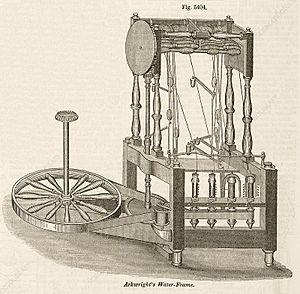Spinning frame facts for kids
The spinning frame was an amazing machine invented during the Industrial Revolution. It helped make thread and yarn from materials like wool and cotton much faster. This important invention came from Britain in the 1700s. It was created by Richard Arkwright and John Kay.
Contents
Spinning Before the Machines
In the 1760s, most yarn in England was made at home. This was called a cottage industry. People used simple tools like a spinning wheel to turn wool, flax, and cotton into thread. It was all done by hand.
But the textile industry was growing fast. New machines, like the flying shuttle, made weaving cloth much quicker. This meant factories needed a lot more yarn than people could make by hand. There just wasn't enough yarn to keep up!
This big demand for yarn led to new inventions. First came the spinning jenny in 1764. Soon after, the spinning frame was invented. It later became known as the water frame when it was improved in 1769. These machines changed everything. By 1830, almost all yarn was made in big factories, not in homes.
How the Spinning Frame Was Made
Richard Arkwright hired John Kay to help him build a new spinning machine. Kay had worked on a similar idea before. With help from other skilled workers, they created the spinning frame.
This new machine made thread that was much stronger than the thread from the spinning jenny. The spinning frame used special parts called draw rollers. These rollers were first invented by Lewis Paul. They helped to stretch the yarn, making it thinner and longer.
How the Rollers Work
The roller spinning process starts with a thick, loose string of fibers. This string is called a roving. The roving goes through three pairs of rollers. Each pair of rollers spins a little faster than the one before it.
This action stretches the roving, making it thinner and longer. After stretching, a special part adds a twist to the yarn. This twist makes the yarn strong. The rollers are spaced carefully so the fibers don't break. They also stop the twist from going back up the roving.
Powering the Machine
The spinning frame was too big to be run by hand. Arkwright first tried using horses to power it. But he soon found a better way: using the power of a water wheel. Because it used water power, the invention became known as the 'water frame'.
For a while, the strong yarn from the spinning frame was used for the lengthwise threads in cloth. These are called warp threads. They hold the cloth together. The weaker yarn from the hand-powered jennies was used for the horizontal filler threads, called weft.
The spinning jennies were cheap and could be used at home. But they needed skill to operate. The spinning frames cost more money to buy. However, they needed less skill to run.


